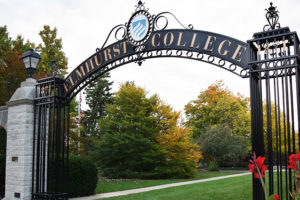
During his 35 years of teaching religious history at the University of Chicago, Martin Marty had a favorite question he liked to ask his students: If you were carving a Mount Rushmore of great American religious thinkers, whose images would make it onto the mountain?
Marty told an overflow audience in the Frick Center on March 6, during the Rudolf G. Schade Lecture, that two names came up again and again in his students’ responses: Reinhold and H. Richard Niebuhr, two brothers who graduated from Elmhurst in 1910 and 1912, respectively, and went on to hugely influential careers at the intersection of theology and public life.
“That’s two out of four figures on our Mount Rushmore produced by a little school of about 150 students at the time,” Marty said. “That’s pretty good.”
Marty, widely considered America’s foremost interpreter of religion and religious history, was on campus to deliver H. Richard Niebuhr: A Centennial Appreciation, in celebration of the anniversary of Niebuhr’s graduation from Elmhurst. Marty is the Fairfax M. Cone Distinguished Service Professor Emeritus at the University of Chicago Divinity School. His honors include a National Book Award (for his 1970 book Righteous Empire: The Protestant Experience in America) and the National Humanities Medal.
Marty has credited Reinhold and H. Richard Niebuhr with “stretching the national mind” with their writing during the middle decades of the 20th century. Richard Niebuhr’s unique contribution, he said, was “to give us a vocabulary and a way of looking” at the ways faith relates to culture. He pointed to Niebuhr’s 1951 book Christ and Culture as “a classic,” a book that forever changed theology and the study of religion.
“A classic is a work of genius that takes root and has an impact after which you can never go back,” Marty said. Today, Niebuhr’s perspectives have become so ingrained in theological discourse that “people don’t even know they’re using them even as they’re acting them out.”
In Christ and Culture, Niebuhr identified five “types” or models for faith’s relationship with its surrounding culture. Monastic or separatist communities, for example, typify the “Christ Against Culture” model. But Marty said the most dominant type in American religious history was a socially ambitious approach that Niebuhr called “Christ Transforming Culture.”
“The impulse there is to do great things and to transform the world,” Marty said. “The downside is that you can veer toward the Utopian and start saying, ‘Don’t you get in our way’” because of a misguided certainty about one’s own rightness. He pointed to the Prohibition movement of the early 20th century as an example of the strength of this transformative approach and of how it ultimately can overreach.
Marty also credited Niebuhr with being the first to give serious scholarly consideration to fundamentalist and evangelical Christians. His 1929 book The Social Sources of Denominationalism portrayed evangelical churches as outcast or disinherited groups. The irony, Marty said, is that evangelical churches now exercise the kind of political power and social influence once reserved for mainline Protestant churches.
Niebuhr served as president of Elmhurst College from 1924 to 1927, then taught theology and Christian ethics at Yale University. The Encyclopedia of Religion and Social Science ranks him “alongside Jonathan Edwards as one of the truly creative American theologians.”